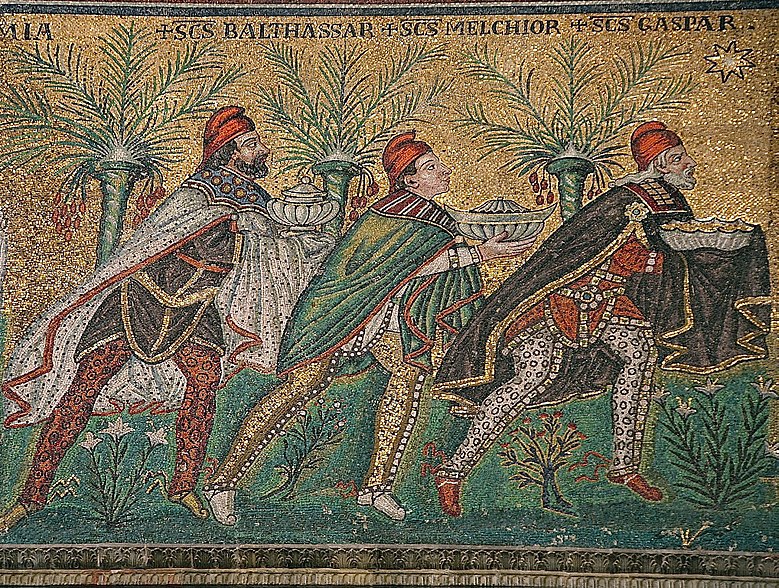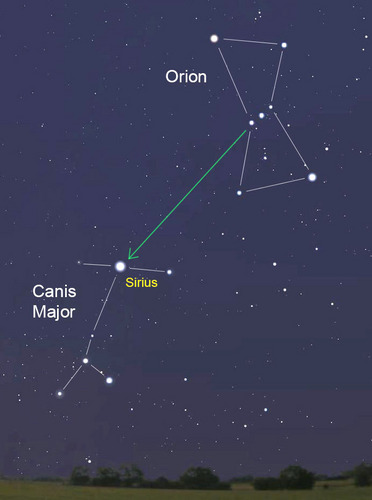



-
Orion is a prominent constellation located on the celestial equator and visible throughout the world. It is one of the most conspicuous and recognizable constellations in the night sky. It was named after Orion, a hunter in Greek mythology.
Orion is very useful as an aid to locating other stars. By extending the line of the Belt southwestward, Sirius (α CMa) can be found; northeastward, Aldebaran (α Tau). A line westward across the two shoulders indicates the direction of Procyon (α CMi). A line from Rigel through Betelgeuse points to Castor and Pollux (α Gem and β Gem).
Additionally, Rigel is part of the Winter Circle. Sirius and Procyon, which may be located from Orion by following imaginary lines (see map), also are points in both the Winter Triangle and the Circle.
Its brightest stars are Rigel (Beta Orionis) and Betelgeuse (Alpha Orionis), a blue-white and a red supergiant respectively. Many of the other brighter stars in the constellation are hot, blue supergiant stars. The three stars in the middle of the constellation form an asterism known as Orion’s belt. The Orion Nebula is located south of Orion’s belt.
Orion’s Belt or the Belt of Orion is an asterism in the constellation Orion. It consists of the three bright stars Alnitak, Alnilam and Mintaka. Looking for Orion’s Belt in the night sky is the easiest way to locate the constellation Orion in the sky.
The stars are more or less evenly spaced in a straight line, and so can be visualized as the belt of the hunter’s clothing. In the Northern hemisphere, they are best visible in the early night sky during the winter, in particular the month of January at around 9.00 pm.
The same three stars are known in Spain, Portugal and South America as “Las Tres Marías”. They also mark the northern night sky when the sun is at its lowest point, and were a clear marker for ancient timekeeping.
In the Philippines and Puerto Rico they are called the Los Tres Reyes Magos. The stars start appearing around the holiday of Epiphany, when the Biblical Magi visited the baby Jesus, which falls on January 6.
Richard Hinckley Allen lists many folk names for the Belt of Orion. The English ones include: Our Lady’s Wand; the Magi; the Three Kings; the Three Marys; or simply the Three Stars.
The Armenians identified their forefather Hayk with Orion. Hayk is also the name of the Orion constellation in the Armenian translation of the Bible. In ancient Aram, the constellation was known as Nephîlā′, the Nephilim may have been Orion’s descendants.
The Babylonian star catalogues of the Late Bronze Age name Orion SIPA.ZI.AN.NA, “The Heavenly Shepherd” or “True Shepherd of Anu” – Anu being the chief god of the heavenly realms.
The Babylonian constellation was sacred to Papshukal and Ninshubur, both minor gods fulfilling the role of ‘messenger to the gods’. Papshukal was closely associated with the figure of a walking bird on Babylonian boundary stones, and on the star map the figure of the Rooster was located below and behind the figure of the True Shepherd – both constellations represent the herald of the gods, in his bird and human forms respectively.
The stars of Orion were associated with Osiris, the sun-god of rebirth and the afterlife, by the ancient Egyptians. In ancient Egypt, the constellation of Orion represented Osiris, who, after being killed by his evil brother Set, was revived by his wife Isis to live immortal among the stars.
Through the hope of new life after death, Osiris began to be associated with the cycles observed in nature, in particular vegetation and the annual flooding of the Nile, through his links with Orion and Sirius at the start of the new year. Osiris was widely worshipped as Lord of the Dead until the suppression of the Egyptian religion during the Christian era.
Orion has also been identified with the Egyptian Pharaoh of the Fifth Dynasty called Unas who, according to the Pyramid Texts, became great by eating the flesh of his mortal enemies and then slaying and devouring the gods themselves. This was based on a belief in contagious magic whereby consuming the flesh of great people would bring inheritance of their power.
After devouring the gods and absorbing their spirits and powers, Unas journeys through the day and night sky to become the star Sahu, or Orion. The Pyramid Texts also show that the dead Pharaoh was identified with the god Osiris, whose form in the stars was often said to be the constellation Orion.
Orion’s current name derives from Greek mythology, in which Orion was a gigantic, supernaturally strong hunter of ancient times, born to Euryale, a nymph, and Poseidon (Neptune), god of the sea in the Greco-Roman tradition.
One myth recounts Gaia’s rage at Orion, who dared to say that he would kill every animal on the planet. The angry goddess tried to dispatch Orion with a scorpion. This is given as the reason that the constellations of Scorpius and Orion are never in the sky at the same time.
However, Ophiuchus, the Serpent Bearer, revived Orion with an antidote. This is said to be the reason that the constellation of Ophiuchus stands midway between the Scorpion and the Hunter in the sky. The constellation is mentioned in Horace’s Odes (Ode 3.27.18), Homer’s Odyssey (Book 5, line 283) and Iliad, and Virgil’s Aeneid (Book 1, line 535)
The Bible mentions Orion three times, naming it “Kesil” (literally – fool). Though, this name perhaps is etymologically connected with “Kislev”, the name for the ninth month of the Hebrew calendar (i.e. November–December), which, in turn, may derive from the Hebrew root K-S-L as in the words “kesel, kisla” (hope, positiveness), i.e. hope for winter rains.): Job 9:9 (“He is the maker of the Bear and Orion”), Job 38:31 (“Can you loosen Orion`s belt?”), and Amos 5:8 (“He who made the Pleiades and Orion”).
In medieval Muslim astronomy, Orion was known as al-jabbar, “the giant”. Orion’s sixth brightest star, Saiph, is named from the Arabic, saif al-jabbar, meaning “sword of the giant”.
Filed under: Uncategorized
